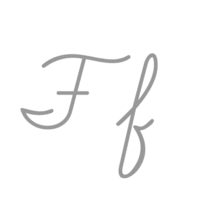F
F or f is the sixth letter in the modern English alphabet and the ISO basic Latin alphabet. Its name in English is ef[1] (pronounced /ˈɛf/), plural efs.[2]
| F | |
|---|---|
| F f | |
| (See below) | |
 | |
| Usage | |
| Writing system | Latin script |
| Type | Alphabetic |
| Language of origin | Latin language |
| Phonetic usage | [f] [ɸ~h] [ʍ~xʷ] [v] /ɛf/ |
| Unicode value | U+0046, U+0066 |
| Alphabetical position | 6 Numerical value: 6 |
| History | |
| Development | |
| Time period | ~-700 to present |
| Descendants | • Ḟ • ₣ • ℉ • ꟻ • ꬵ • ∫ • 𝆑 |
| Sisters | U V W Y Ʊ У Ў Ұ Υ υ ו וּ וֹ و ۋ ܘ ࠅ 𐎆 𐌖 Վ վ Ո ո Ւ ւ և |
| Transliteration equivalents | U V W Y |
| Variations | (See below) |
| Other | |
| Other letters commonly used with | f(x) |
| Associated numbers | 6 |
|
History
| Proto-Semitic W |
Phoenician waw |
Greek Digamma |
Etruscan V or W |
Roman F |
|---|---|---|---|---|
The origin of 'F' is the Semitic letter vâv (or waw) that represented a sound like /v/ or /w/. Graphically it originally probably depicted either a hook or a club. It may have been based on a comparable Egyptian hieroglyph such as that which represented the word mace (transliterated as ḥ(dj)):
The Phoenician form of the letter was adopted into Greek as a vowel, upsilon (which resembled its descendant 'Y' but was also the ancestor of the Roman letters 'U', 'V', and 'W'); and, with another form, as a consonant, digamma, which indicated the pronunciation /w/, as in Phoenician. Latin 'F,' despite being pronounced differently, is ultimately descended from digamma and closely resembles it in form.
After sound changes eliminated /w/ from spoken Greek, digamma was used only as a numeral. However, the Greek alphabet also gave rise to other alphabets, and some of these retained letters descended from digamma. In the Etruscan alphabet, 'F' probably represented /w/, as in Greek, and the Etruscans formed the digraph 'FH' to represent /f/. (At the time these letters were borrowed, there was no Greek letter that represented /f/: the Greek letter phi 'Φ' then represented an aspirated voiceless bilabial plosive /pʰ/, although in Modern Greek it has come to represent /f/.) When the Romans adopted the alphabet, they used 'V' (from Greek upsilon) not only for the vowel /u/, but also for the corresponding semivowel /w/, leaving 'F' available for /f/. And so out of the various vav variants in the Mediterranean world, the letter F entered the Roman alphabet attached to a sound which its antecedents in Greek and Etruscan did not have. The Roman alphabet forms the basis of the alphabet used today for English and many other languages.
The lowercase 'f' is not related to the visually similar long s, 'ſ' (or medial s). The use of the long s largely died out by the beginning of the 19th century, mostly to prevent confusion with 'f' when using a short mid-bar.
Use in writing systems
English
In the English writing system ⟨f⟩ is used to represent the sound /f/, the voiceless labiodental fricative. It is often doubled at the end of words. Exceptionally, it represents the voiced labiodental fricative /v/ in the common word "of". F is the twelfth least frequently used letter in the English language (after C, G, Y, P, B, V, K, J, X, Q, and Z), with a frequency of about 2.23% in words.
Other languages
In the writing systems of other languages, ⟨f⟩ commonly represents /f/, [ɸ] or /v/.
- In French orthography, ⟨f⟩ is used to represent /f/. It may also be silent at the end of words.
- In Spanish orthography, ⟨f⟩ is used to represent /f/.
- In the Hepburn romanization of Japanese, ⟨f⟩ is used to represent [ɸ]. This sound is usually considered to be an allophone of /h/, which is pronounced in different ways depending upon its context; Japanese /h/ is pronounced as [ɸ] before /u/.
- In Welsh orthography, ⟨f⟩ represents /v/ while ⟨ff⟩ represents /f/.
- In Slavic languages, ⟨f⟩ is used primarily in words of foreign (Greek, Latin, or Germanic) origin.
- In spoken Icelandic, ⟨f⟩ in the middle of a word is often pronounced as a v (e.g. Að sofa - to sleep).
International Phonetic Alphabet
The International Phonetic Alphabet uses ⟨f⟩ to represent the voiceless labiodental fricative.
In mathematics
An italic letter f is conventionally used to denote an arbitrary function. See also f with hook (ƒ).
Other uses
The letter F has become an Internet meme, where it is used to pay respects. This use is derived from the 2014 video game Call of Duty: Advanced Warfare, where in a quick-time event protagonist Jack Mitchell must pay his respects to his friend Will Irons who fell in combat in a previous mission, represented by the player pressing F when playing the PC version.[3]
Related characters
Ancestors, descendants and siblings
- F with diacritics: Ƒ ƒ Ḟ ḟ Ꞙ ꞙ ᵮ ᶂ[4] ᵮ[5]
- Ꞙ ꞙ : F with stroke is used in the Teuthonista phonetic transcription system,[6] and older Ewe writing[7]
- ꬵ : Lenis F is used in the Teuthonista phonetic transcription system[6]
- ᶠ : Modifier letter small f is used for phonetic transcription[4]
- ꜰ : Small capital F was used in the Icelandic First Grammatical Treatise to mark gemination[8]
- Ꝼ ꝼ : Insular F is used in Norse and Old English contexts[9]
- ꟻ : Reversed F was used in ancient Roman texts to stand for filia (daughter) or femina (woman)[10]
- Ⅎ ⅎ : Claudian letters[11]
- 𐤅: Semitic letter Waw, from which the following symbols originally derive
- Ϝ ϝ : Greek letter Digamma, from which F derives
- 𐌅 : Old Italic V/F (originally used for V, in languages such as Etruscan and Oscan), which derives from Greek Digamma, and is the ancestor of modern Latin F
- Y y : Latin letter Y, sharing its roots with F
- V v : Latin letter V, also sharing its roots with F
- U u : Latin letter U, which is descended from V
- W w : Latin letter W, also descended from V
- Ϝ ϝ : Greek letter Digamma, from which F derives
Ligatures and abbreviations
- ₣ : French franc, Latin capital letter F with stroke
- ℉ : degree Fahrenheit
Computing codes
| Preview | F | f | ||
|---|---|---|---|---|
| Unicode name | LATIN CAPITAL LETTER F | LATIN SMALL LETTER F | ||
| Encodings | decimal | hex | decimal | hex |
| Unicode | 70 | U+0046 | 102 | U+0066 |
| UTF-8 | 70 | 46 | 102 | 66 |
| Numeric character reference | F | F | f | f |
| EBCDIC family | 198 | C6 | 134 | 86 |
| ASCII 1 | 70 | 46 | 102 | 66 |
- 1 Also for encodings based on ASCII, including the DOS, Windows, ISO-8859 and Macintosh families of encodings.
Other representations
| NATO phonetic | Morse code |
| Foxtrot |
 |
|
 |
 |
| Signal flag | Flag semaphore | American manual alphabet (ASL fingerspelling) | Braille dots-124 Unified English Braille |
References
- Spelled eff when used as a verb
- "F", Oxford English Dictionary, 2nd edition (1989); "ef", "eff", "bee" (under "bee eff"), op. cit.
- "Press F to pay respects". Retrieved 15 March 2020.
- Constable, Peter (2004-04-19). "L2/04-132 Proposal to add additional phonetic characters to the UCS" (PDF).
- Constable, Peter (2003-09-30). "L2/03-174R2: Proposal to Encode Phonetic Symbols with Middle Tilde in the UCS" (PDF).
- Everson, Michael; Dicklberger, Alois; Pentzlin, Karl; Wandl-Vogt, Eveline (2011-06-02). "L2/11-202: Revised proposal to encode "Teuthonista" phonetic characters in the UCS" (PDF).
- Latin Extended-D
- Everson, Michael; Baker, Peter; Emiliano, António; Grammel, Florian; Haugen, Odd Einar; Luft, Diana; Pedro, Susana; Schumacher, Gerd; Stötzner, Andreas (2006-01-30). "L2/06-027: Proposal to add Medievalist characters to the UCS" (PDF).
- Everson, Michael (2006-08-06). "L2/06-266: Proposal to add Latin letters and a Greek symbol to the UCS" (PDF).
- Perry, David J. (2006-08-01). "L2/06-269: Proposal to Add Additional Ancient Roman Characters to UCS" (PDF).
- Everson, Michael (2005-08-12). "L2/05-193R2: Proposal to add Claudian Latin letters to the UCS" (PDF).
